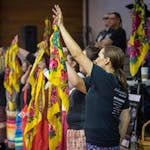For decades, Betsy Ross' Bible sat open to the same page inside the narrow Arch Street row house where she is said to have sewn the nation's first flag. On the exposed paper was the Ross family tree, written in script but rendered illegible in places, a faded and discolored victim of humidity, heat and sunlight.
By the time Lisa Acker Moulder joined the historic house museum as collections manager in 2000, the Bible, published in 1791, was in such fraught condition that Moulder stashed it away in storage, displaying it only for the few days in 2015 that Pope Francis was in town.
Soon, though, the Bible will re-emerge refreshed after a six-week stay at the Conservation Center for Art and Historic Artifacts in Philadelphia and return to its home, where it will be put on limited exhibition.
The $11,000 preservation project came of a partnership between Historic Philadelphia, the private nonprofit that operates the Betsy Ross House, and the American Bible Society (ABS), an organization that has been promoting the Good Book for the past two centuries. In 2015, ABS moved its headquarters from New York to Fifth Street near Independence Hall in Old City, where it is building a new museum on the role of faith in American history.
ABS has an extensive collection of rare Bibles, including Helen Keller's. Funding the restoration of the Ross family Bible fit right into the group's "sweet spot," said Patrick Murdock, managing director of ABS' Faith and Liberty Discovery Center, which is expected to open in 2020.
The Bible is one of the few Ross artifacts extant and a key piece of history, so its preservation is crucial, said Amy Needle, president and CEO of Historic Philadelphia.
With ABS support, the ailing Bible was checked into the Conservation Center, which has preserved Frank Lloyd Wright's architectural drawings, John James Audubon's Birds of America prints and Bruce Springsteen's lyric notebooks.
When the Bible arrived in October, its leather covers were detached and the binding crumbled. The book was split apart into seven sections. Pages were discolored, stained and brittle, and some had been torn out.
It had been given to Betsy Ross at the behest of her aunt, Sarah Halloway, who had stipulated in her will that Bibles be purchased for some of her nieces and nephews after both she and her brother, Samuel Griscom, died, in 1789 and 1793 respectively.
Ross received her Bible in 1794, nearly two decades after she is said to have sewn the first flag in the upholstery shop/boardinghouse where she lived and worked as a young widow in 1776.
"Making the flag was a treasonous act," said the Ross House's Moulder, who described Ross as a "rebellious working woman who probably struggled [financially] and took on the dangerous task of sewing the flag because she needed the money."
Inside the Bible is a family tree created by Ross' third husband, John Claypoole. It lists the couple's parents, children and some grandchildren, among other relatives. Ross had two daughters with her second husband, Joseph Ashburn, and five daughters with Claypoole, but two of her children died in infancy.
Ross' signature does not appear in the Bible, but can be found on a separate page tucked into the book on which Claypoole and Ross, as Elizabeth Claypoole, signed their names.
Following her death at age 84 in 1836, the Bible was passed down in the family. It was donated to the Betsy Ross House in 1949 by three descendants, Catherine B. Swift, John Balderston and Mrs. Thomas Jones. The Bible was exhibited on a shelf in a corner cupboard, near a window in the parlor. It was there that George Washington, Robert Morris (a wealthy merchant known as the "financier" of the American Revolution), and George Ross (a signer of the Declaration of Independence and the uncle of Betsy's first husband, John Ross) are said to have met with her to ask her to make the flag.
At the Conservation Center, the damaged book landed in the expert hands of Jungohk Theresa Cho, senior book conservator, who over the course of six weeks performed a 50-hour operation to repair it.
Cho reinstalled detached pages, discarded the spine's crumbling leather binding and reconstructed it using new material. She reinforced the leather cover with special paper, toning and staining it to mimic its original color. She cleaned up browned and faded pages so that the family tree could once again be read.
The Bible will return to the Betsy Ross House in the next few weeks. Officials plan to unveil it during Flag Day celebrations in June, when it will be shown in a custom case made of protective museum-quality glass as part of rotating exhibitions sometimes on display, sometimes in storage.





